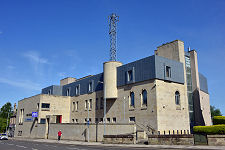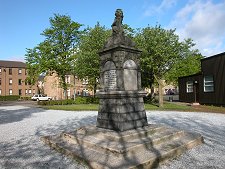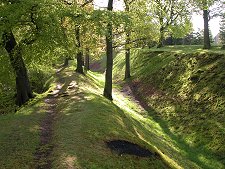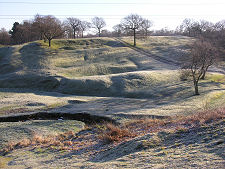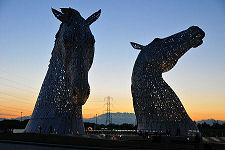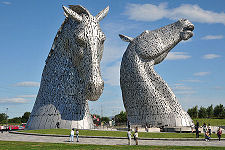 Falkirk High Street and Steeple |
Falkirk lies at the heart of central Scotland. On the main road from Edinburgh to Stirling, it is also at the meeting point of Scotland's two major lowland canals and is served by the country's busiest railway line, from Edinburgh to Glasgow. Falkirk can also lay claim to having been the engine of the industrial revolution in Scotland.
Perhaps as a result of its industrial past, Falkirk was long overlooked as a visitor destination. The corner was turned with the opening of the Falkirk Wheel in 2002, an engineering wonder equal to anything the Victorians achieved. It links the Firth and Clyde Canal to the Union Canal, allowing the full return to use of both after many decades of closure. Replacing a flight of 11 locks, the Falkirk Wheel returned Falkirk to the must-see lists of visitors to central Scotland.
But there's much more to Falkirk than just the Wheel. Alongside the main approach road to the Falkirk Wheel from the centre of town, at Watling Lodge, is a stretch of the Antonine Wall. Less well known than Hadrian's Wall, this 37 mile turf wall and ditch was built in AD142-3 during one of the Romans' several excursions into Scotland. It runs right through Falkirk, and the line of the wall can also be traced to the east of the town centre in the grounds of Callendar House. Perhaps the best preserved stretch of the wall lies half a mile west of the Falkirk Wheel: at Rough Castle Roman Fort. (Continues below images...)
 Falkirk Old and St Modan's Parish Church |
 The Falkirk Wheel |
Closer to the M9 is The Helix, a 350 hectare public space developed with lottery money. It is home to the Kelpies, two horses heads forming the largest equine artworks in the world at 30m high. Another of Falkirk's attractions is Callendar House, which would look more at home in central France than in central Scotland. With a 300ft long frontage this incredible château evolved through many stages from its origins as a castle in about 1400.
To add to the critical mass of attractions in the town, two distilleries offering tours have opened or reopened in relatively recent times: Rosebank Distillery and Falkirk Distillery. Meanwhile at Carron, a northern neighbour to Falkirk, you can find the old clocktower entrance to the Carron Company, once the largest ironworks in Europe.
Falkirk lists, amongst its other claims to fame, the sites of two battles. The first took place on 22 July 1298 and proved to be the battle at which William Wallace lost the advantage he had earlier gained over the English at the Battle of Stirling Bridge. Today the battle is commemorated by a memorial on the edge of Victoria Park, on the north side of Falkirk, though many believe the battle actually took place on a site now just to the east of the town.
The Second Battle of Falkirk, or the Battle of Falkirk Muir, took place some 450 years later, on 17 January 1746. Here Bonnie Prince Charlie's Jacobites defeated Government forces pursuing them, but then failed to capitalise on their victory. This happened on the south-west edge of today's Falkirk and the site is marked by a monument.
Falkirk's focal position was recognised early in its life. By 1710 the Falkirk Tryst had been established to the south of the town. This was a market held from August to October each year at which Highland cattle driven from all parts of of the Highlands and Islands were sold to buyers who then drove them on to England or slaughtered and processed them locally. Over the 1700s Falkirk gradually replaced Crieff as the centre of this trade.
Today's Falkirk is a pleasant town with its pedestrianised High Street at its heart. The main landmark is the Steeple, a 140ft high building erected in the market place in 1814. The Steeple was struck by lightning in 1927 and the top 30ft collapsed, killing an unlucky horse. It was later rebuilt. Behind the Steeple is Tolbooth Street. This houses the Tolbooth Tavern, carrying a sign proclaiming it to be the "Tollbooth" Tavern, a typo many of us have perpetrated in our time.
Overlooking the High Street is Falkirk Old and St Modan's Parish Church, also known as "Falkirk Trinity Church". Built in stages over the period from 1450 to 1892 the church is only the latest of a series on this site, probably dating back as far as the AD600s. One of the earlier churches, built here in 1057, became known because of its appearance as Eglesbreth, the Cumbric for "Speckled Church". This translated into Scots as "Faw Kirk", which over time became "Falkirk".
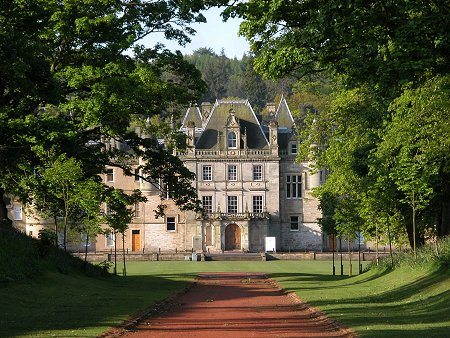 Callendar House |
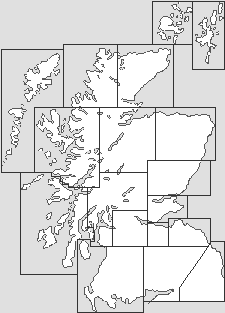
|
|
|
Visitor InformationView Location on MapWhat3Words Location: ///cans.boats.stops |
 The Burgh Buildings |
 Vicar Street |
 Falkirk Grahamston Station |
 St Francis Xavier's RC Church |
 Royal Bank of Scotland |
 King's Court |
 High Street |
 Rosebank Distillery |
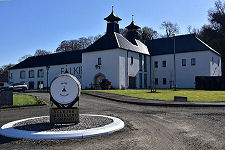 Falkirk Distillery |
 Carron Company Clocktower |


